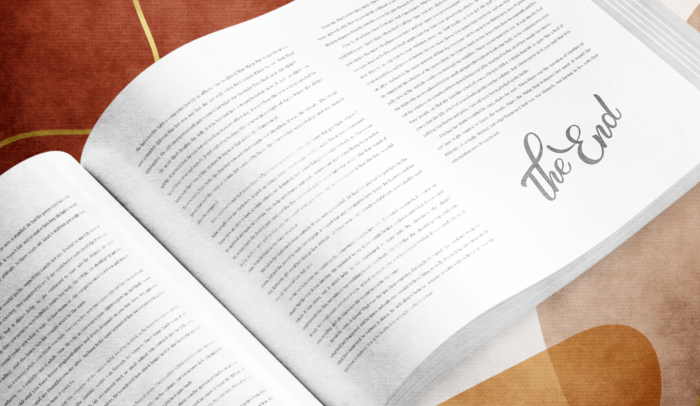Here’s the thing about ending your book the right way:
If the reader got all the way to the conclusion, that means they read the whole book, they liked it, and now they want to wrap this up.
So don’t ramble on and on. Give them what they want.
The goal of a great ending is to tie everything together, neatly summarize your book, and then provide a specific call or calls to action for your reader.
Don’t overcomplicate the conclusion—just let it do its job, and it’ll work great.
What a Good Ending Should Do
- Clearly summarize the book: That’s the best thing you can do, not only to deliver value to the reader but also to make the book memorable (and recommendable).
- Address any lingering issues and close any open loops: The reader should feel like everything is wrapped up in a bow.
- Provide a call to action: In essence, tell the reader what to do.
- Give even more: Point them to any additional resources you have that could help them.
What the End of the Book Should NOT Do
- A conclusion should NOT introduce any new content: This should only be a summarization of what’s in the book. You can have new stories or anecdotes, of course.
- A conclusion should not be too long: The rule of thumb is that it should be the shortest chapter in your book.
- A conclusion should not break faith with the reader: Don’t tell them “operators are standing by” or try to sell them in a preposterous way that turns them off.
How to End a Book (And Get Readers Talking About It)
At Scribe, we like to outline the conclusion using this template:
- Grab the reader with a great hook
- Restate the book’s thesis
- Summarize the chapters
- Call to action: what should the reader do when they finish the book?
1. Hook
This is one of the most important writing tips for any Author:
Every chapter should start with a hook. Even the last one.
This can be a story that summarizes the book, or you can close a loop from earlier in the book. But the point is, the reader should feel like they do at the end of a good movie, where everything feels nicely summarized with a satisfying ending.
By this time, you’ve mentioned a lot of different topics. Usually, the easiest and most compelling way to begin the conclusion is by referring back to one (or more) of them. Or you can add another dimension to a story you already told or tie up loose ends.
2. Restate the book’s mission/thesis
This is pretty simple, but make sure you restate the book’s thesis. From the first chapter to the final chapter, your book’s primary message should be consistent.
3. Summarize chapters
This is optional, but most good nonfiction books do this. They summarize the key points so succinctly and clearly that the reader can’t help but understand your lessons the same way that you do.
You want the reader to think about and talk about your book to their friends the same way you would if you could be there yourself. The best way to make sure they do that is to tell them exactly what to say.
That’s what this section is for.

Specifically, it’s about nailing whatever you want your readers to remember about your book. What are the takeaways that really matter? How do you want them to talk about them?
If your book is a memoir, your conclusion also needs to complete your story arc, tying up any plot threads and subplots in your storyline so you don’t leave any cliffhangers.
You might not summarize the plot points of each chapter literally, but you still want to remind your readers of the journey.
4. Call to action
What’s the first thing you want your reader to do when they finish the last word and put the book down? This is usually the final word, and it’s what you should leave them with on the final page.
Note on the call to action
A call to action (CTA) is not required in a conclusion, but most nonfiction books have them. It’s usually the very last bit of the conclusion, the final word to readers, and it ensures they know what you want them to do.
Authors generally adopt a different tone with the CTA—one that’s not just more explicitly inspirational but that’s also framed as an imperative. The underlying message of the call to action is straightforward and empowering: now that you have all the tools, go out there and use them.
This is good, and readers tend to like it. Some authors feel uncomfortable including such a direct appeal to readers because they may feel it’s unprofessional, and they can be right (sometimes).
Authors often want to be too inspirational in the introduction, and not enough in the conclusion. But this is when you can really tell your reader what to do, and be very direct.
What you do not want to do is write a glorified sales brochure. The last thing you want to do here is try to pitch them something of yours to buy.
Think about it—you’ve spent the whole book earning their trust, and now you ruin it with a bad ending that tries to sell them?
Don’t do that. Most importantly because it doesn’t work very well.
Readers are smart. They’re interested in your topic because they’ve picked up your book. If they’ve made it this far, then they’ve already read an entire book’s worth of your knowledge and expertise.
They can form their own conclusions when it comes to contacting you.
That said, if you do want to suggest they contact you, do so authentically—from a place of trying to help them, not yourself. Tell them you want to hear from them, or that you want to help them move forward.
If your website or the name of your firm is in your bio or About the Author page, that’s sufficient. Give them your email in the conclusion if you like—but only if you’re sincere about responding to them.
Ultimately, your goal is to provide so much value to them that they respect and admire you and your work, and choose to contact you because they have sold themselves on wanting to, not because you sold them.
Some authors want a more explicit CTA, such as directing readers of the book to a specific landing page. This can work, as long as the page you’re directing them to gives the reader something.
But it has to be something they’ll see as extra, not something they’ll feel should have been in the book. For example, a map or chart that is additive, but not crucial, to the content is great.
What you don’t want to do is give them something on a landing page that makes them think, “Why isn’t this in the book?” That just breaks faith with the reader.
Great Conclusion Examples
1. Syndicating is a B*tch, by Bruce Petersen
“The most tangible stress of managing a syndication deal happens prior to close. You’re taking care of a lot of moving pieces and are responsible for a lot of money for a lot of people, and that’s a lot. Once the deal closes, that’s it. There’s not a lot happening at that point.
That doesn’t mean the stress has ended. The more experience you gain doing deals, the more prepared you’re going to be for the weird things that come up—and something will always come up. Remember when I lost $5.2 million to OFAC? I was completely blindsided that first time, and as I’m writing this book, it happened again. Yep.”
This is a fantastic example of how to start a well-structured conclusion. The author leads by talking about closing a deal, just as he’s closing his book. There’s a parallel structure there that orients the reader to the end of the book.
He also refers back to something that happened earlier in the book, then leads into a story about the same thing happening again. The new story hooks the reader while reminding them of an important point he made earlier.
2. Breakthrough Leadership Team, by Mike Goldman
“You’ve just finished reading this book, and your head is swimming with ideas. You’re probably wondering, Where do I begin?
I suggest you start by measuring where you are in your journey toward becoming a Breakthrough Leadership Team …”
Here, again, the opening lines of the conclusion orient the reader, signaling to them that they have reached the final chapter. In this case, the Author jumps immediately into helping the reader figure out what to do next.
The title of this final chapter, by the way, is “Call to Action.” It’s the theme of the whole chapter, reminding the reader of their journey throughout the book and suggesting what to do next.
3. Beyond Wins, by Mala Subramaniam
“Did the book address questions posed in the OpeningThoughts?
Why do I feel like I am on a seesaw of wins and losses in my business negotiations? Even when I win, I sometimes feel like I lost something. Tools and techniques I picked up in books and training are not foreign, so what am I missing? What will put me on the path to success? What Is the yardstick for success?
It did for Paula of the Adrift Website Case, which is a real success story.”
This Author begins her conclusion by returning to and listing the questions she asked at the beginning. As the book ends, she reminds the reader of where the journey started, then immediately leads into a new story.
While you shouldn’t introduce new concepts in a conclusion, new stories that drive key concepts home are a great way to leave the reader with a memorable application of what they’ve learned.


